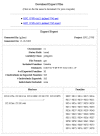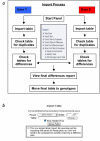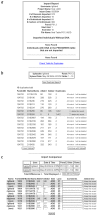GeneLink: a database to facilitate genetic studies of complex traits
- PMID: 15491493
- PMCID: PMC526767
- DOI: 10.1186/1471-2164-5-81
GeneLink: a database to facilitate genetic studies of complex traits
Abstract
Background: In contrast to gene-mapping studies of simple Mendelian disorders, genetic analyses of complex traits are far more challenging, and high quality data management systems are often critical to the success of these projects. To minimize the difficulties inherent in complex trait studies, we have developed GeneLink, a Web-accessible, password-protected Sybase database.
Results: GeneLink is a powerful tool for complex trait mapping, enabling genotypic data to be easily merged with pedigree and extensive phenotypic data. Specifically designed to facilitate large-scale (multi-center) genetic linkage or association studies, GeneLink securely and efficiently handles large amounts of data and provides additional features to facilitate data analysis by existing software packages and quality control. These include the ability to download chromosome-specific data files containing marker data in map order in various formats appropriate for downstream analyses (e.g., GAS and LINKAGE). Furthermore, an unlimited number of phenotypes (either qualitative or quantitative) can be stored and analyzed. Finally, GeneLink generates several quality assurance reports, including genotyping success rates of specified DNA samples or success and heterozygosity rates for specified markers.
Conclusions: GeneLink has already proven an invaluable tool for complex trait mapping studies and is discussed primarily in the context of our large, multi-center study of hereditary prostate cancer (HPC). GeneLink is freely available at http://research.nhgri.nih.gov/genelink.
Figures










References
-
- Rommens JM, lannuzzi MC, Kerem B, Drumm ML, Melmer G, Dean M, Rozmahel R, Cole JL, Kennedy D, Hidaka N, Zsiga M, Buchwald M, Riordan J, Tsui L, Collins FS. Identification of the cystic fibrosis gene: chromosome walking and jumping. Science. 1989;245:1059–1065. - PubMed
-
- Riordan JR, Rommens JM, Kerem B, Alon N, Rozmahel R, Grzelczak Z, Zielenski J, Lok S, Plavsic N, Chou JL, Drumm ML, lannuzzi MC, Collins FS. Identification of the cystic fibrosis gene: cloning and characterization of complementary DNA. Science. 1989;245:1066–1073. - PubMed
-
- Lange EM, Gillanders EM, Davis CC, Brown WM, Campbell JK, Jones M, Gildea D, Riedesel E, Albertus J, Freas-Lutz D, Markey C, Giri V, Dimmer JB, Montie JE, Trent JM, Cooney KA. Genome-wide scan for prostate cancer susceptibility genes using families from the University of Michigan prostate cancer genetics project finds evidence for linkage on chromosome 17 near BRCA1. Prostate. 2003;57:326–334. doi: 10.1002/pros.10307. - DOI - PubMed
-
- Schleutker J, Baffoe-Bonnie AB, Gillanders E, Kainu T, Jones MP, Freas-Lutz D, Markey C, Gildea D, Riedesel E, Albertus J, Gibbs KD, Jr, Matikainen M, Koivisto PA, Tammela T, Bailey-Wilson JE, Trent JM, Kallioniemi OP. Genome-wide scan for linkage in finnish hereditary prostate cancer (HPC) families identifies novel susceptibility loci at 11ql4 and 3p25-26. Prostate. 2003;57:280–289. doi: 10.1002/pros.10302. - DOI - PubMed
Publication types
MeSH terms
Substances
LinkOut - more resources
Full Text Sources

